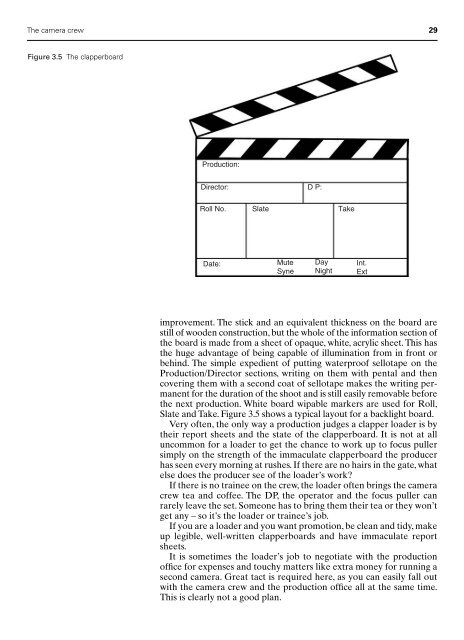1 The Director of Photography – an overview
1 The Director of Photography – an overview
1 The Director of Photography – an overview
Create successful ePaper yourself
Turn your PDF publications into a flip-book with our unique Google optimized e-Paper software.
<strong>The</strong> camera crew 29<br />
Figure 3.5 <strong>The</strong> clapperboard<br />
Production:<br />
<strong>Director</strong>: D P:<br />
Roll No. Slate Take<br />
Date:<br />
Mute<br />
Syne<br />
Day<br />
Night<br />
Int.<br />
Ext<br />
improvement. <strong>The</strong> stick <strong>an</strong>d <strong>an</strong> equivalent thickness on the board are<br />
still <strong>of</strong> wooden construction, but the whole <strong>of</strong> the information section <strong>of</strong><br />
the board is made from a sheet <strong>of</strong> opaque, white, acrylic sheet. This has<br />
the huge adv<strong>an</strong>tage <strong>of</strong> being capable <strong>of</strong> illumination from in front or<br />
behind. <strong>The</strong> simple expedient <strong>of</strong> putting waterpro<strong>of</strong> sellotape on the<br />
Production/<strong>Director</strong> sections, writing on them with pental <strong>an</strong>d then<br />
covering them with a second coat <strong>of</strong> sellotape makes the writing perm<strong>an</strong>ent<br />
for the duration <strong>of</strong> the shoot <strong>an</strong>d is still easily removable before<br />
the next production. White board wipable markers are used for Roll,<br />
Slate <strong>an</strong>d Take. Figure 3.5 shows a typical layout for a backlight board.<br />
Very <strong>of</strong>ten, the only way a production judges a clapper loader is by<br />
their report sheets <strong>an</strong>d the state <strong>of</strong> the clapperboard. It is not at all<br />
uncommon for a loader to get the ch<strong>an</strong>ce to work up to focus puller<br />
simply on the strength <strong>of</strong> the immaculate clapperboard the producer<br />
has seen every morning at rushes. If there are no hairs in the gate, what<br />
else does the producer see <strong>of</strong> the loader’s work?<br />
If there is no trainee on the crew, the loader <strong>of</strong>ten brings the camera<br />
crew tea <strong>an</strong>d c<strong>of</strong>fee. <strong>The</strong> DP, the operator <strong>an</strong>d the focus puller c<strong>an</strong><br />
rarely leave the set. Someone has to bring them their tea or they won’t<br />
get <strong>an</strong>y <strong>–</strong> so it’s the loader or trainee’s job.<br />
If you are a loader <strong>an</strong>d you w<strong>an</strong>t promotion, be cle<strong>an</strong> <strong>an</strong>d tidy, make<br />
up legible, well-written clapperboards <strong>an</strong>d have immaculate report<br />
sheets.<br />
It is sometimes the loader’s job to negotiate with the production<br />
<strong>of</strong>fice for expenses <strong>an</strong>d touchy matters like extra money for running a<br />
second camera. Great tact is required here, as you c<strong>an</strong> easily fall out<br />
with the camera crew <strong>an</strong>d the production <strong>of</strong>fice all at the same time.<br />
This is clearly not a good pl<strong>an</strong>.

















